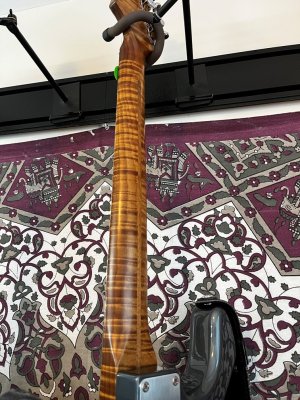johnnyj
Junior Member
- Messages
- 67
Hi guys,
i just received my second warmoth build parts. I ordered an unfinished RM neck with RM fretboard and plan to finish it with some few doeses of tru oil. My goal is to make the wood details pop out a bit more with higher contrast and that ideally i would archieve a slightly smooth "oily" feel at the neck. even after spending two nights in reading myself into this topic i still feel not informed enough to start. so i would be very much interested in your opionion on my open questions:
1. will TO alone be sufficiant to reach my goal or do i also need wax for this afterwards as well?
2. i dont want to have a thick layer of the finish on it and remain the woody character. in this case, how much layers of tru oil would you recommend?
3. when do you need to sand down the neck? is this at all needed if you would just apply 2 or 3 times? will the improved dramatic look come because of the sanding or because the oil is getting into the pores?
4. after finishing with TO, can you still apply care products such as lemon oil? if no, what would you recommend as the usual cleaning ritual?
5. some people report that their finishing went wrong and the neck becomes sticky after TO. any recommendations how to prevent this? and if it works out perfectly, would you say that TO can make the feel more smooth compared to unfinished?
6. any concerns of finishing the fretboard aswell with TO?
7. would you also oil the neck joint part of the neck (the part that is pressed against the body) or will this affect the joint negatively?
thanks and best
johnny
i just received my second warmoth build parts. I ordered an unfinished RM neck with RM fretboard and plan to finish it with some few doeses of tru oil. My goal is to make the wood details pop out a bit more with higher contrast and that ideally i would archieve a slightly smooth "oily" feel at the neck. even after spending two nights in reading myself into this topic i still feel not informed enough to start. so i would be very much interested in your opionion on my open questions:
1. will TO alone be sufficiant to reach my goal or do i also need wax for this afterwards as well?
2. i dont want to have a thick layer of the finish on it and remain the woody character. in this case, how much layers of tru oil would you recommend?
3. when do you need to sand down the neck? is this at all needed if you would just apply 2 or 3 times? will the improved dramatic look come because of the sanding or because the oil is getting into the pores?
4. after finishing with TO, can you still apply care products such as lemon oil? if no, what would you recommend as the usual cleaning ritual?
5. some people report that their finishing went wrong and the neck becomes sticky after TO. any recommendations how to prevent this? and if it works out perfectly, would you say that TO can make the feel more smooth compared to unfinished?
6. any concerns of finishing the fretboard aswell with TO?
7. would you also oil the neck joint part of the neck (the part that is pressed against the body) or will this affect the joint negatively?
thanks and best
johnny
Last edited:



